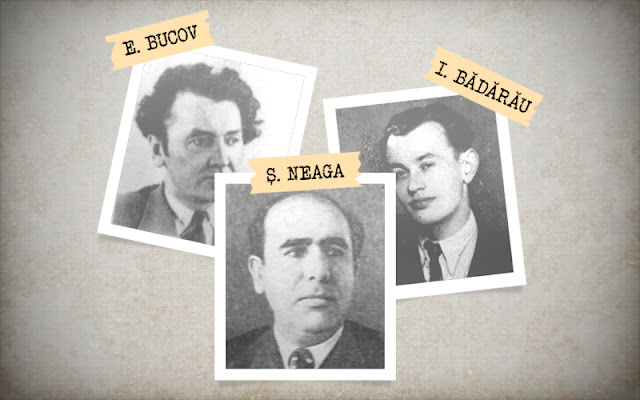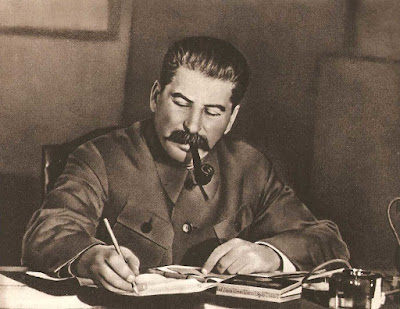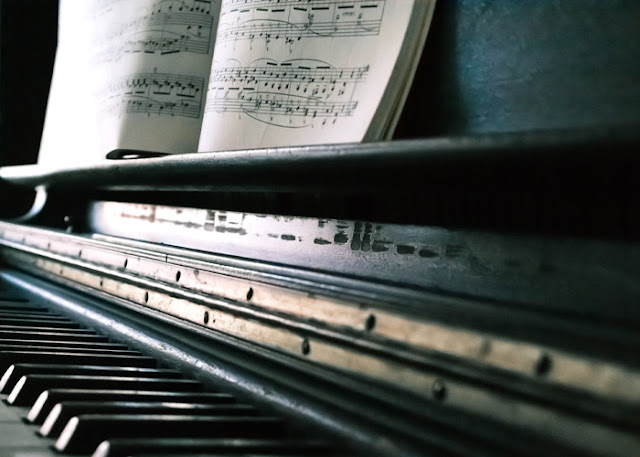The Complete History of the Moldovan SSR Anthem
Ștefan Neaga and the Moldovan SSR Anthem
The National Anthem of the Moldavian Soviet Socialist Republic is one of the most recurrent topics in the videos of the anthem community members in YouTube. The story that surrounds the anthem composed in 1945 has captivated the minds of people around the world and it revealed, perhaps, one of the biggest mysteries about national anthems in recent history. It all started when members of the “Ștefan Neaga Commission” uploaded a video focusing in the difference between the known vocal and instrumental versions of the Moldovan SSR State Anthem. And you know the rest…
 |
| Flag of the Moldovan SSR (Shutterstock) |
The music for the anthem was composed in 1945 by Moldovan composer Ştefan
Neaga (1900-1951) and the lyrics were written by Emilian Bucov and Ion Bădărău
(who used the pseudonym “Bogdan Istru”). World War II had just ended, and many
initiatives were taken by the central committee of the CPSU to celebrate the
great victory of the Soviet Union in the Great Patriotic War and to give each
Soviet Republic a unique identity. For this matter, the Government of the
Soviet Republic of Moldova designed General Iosif Mordoveț with the task to
find a composer and lyricists for the new anthem. Mordoveț contacted with the
mentioned authors and forced them to create a melody that represented Moldovan
people
According to Lilia Cazacu (2010), the members of the Supreme Soviet of
the Moldovan SSR decided that the creation of the anthem was critical and that
it had to follow several rules and exalt the role of the Communist Party and
Iosif Stalin in the liberation of Moldova from the bourgeoisie and capitalism,
the expulsion of fascists from Moldova, and the development of the Moldovan
State based on the Socialist form of society and the fraternity among Soviet
republics. Although Mordoveț selected Neaga, Bucov and Bădărău for the job,
several other composers such as Emil Samoilă, Leonid Cornenanu, and Liviu
Deleanu created lyrics for an anthem following these indications between 1944
and 1945. In the end, these lyrics were not used and, in fact, Delenau’s lyrics
were aggressively rejected. However, at the time of the publication of this
article, it is not clear if the lyrics wrote by these authors were made for
Neaga’s composition or compositions of their own. The evidence suggests that,
given the fact that Neaga and two poets worked very close, the lyrics were
written for different musical compositions or written without a finished
melody.
 |
| Resources from Freepik.com |
During the task commissioned by Mordoveț, Neaga worked day and night to
ensure a perfect melody structure for the anthem. Emilian Bucov remembered how
demanding was this task for Neaga, and that many variations of the melody were made
because of that. Each time a melody was completed, Neaga was dissatisfied, so
they had to start all over again. The composer was very demanding and
self-critic with his work and proves how committed was to complete the task. The
authors wanted to create an anthem that inspired a deep patriotic feeling in
the people of Moldova, and that made a person stood up immediately as soon as
he heard the melody
By 1945 the melody was complete and Bucov and Bădărău had already
written the lyrics. In the same year, the Supreme Soviet of the Moldovan SSR officialised
Neaga’s composition as the State Anthem of the Moldovan SSR (Imnul de Stat al
RSS Moldovenești). And thus, it entered in the Republic’s State symbols under
the Constitution of the Moldovan SSR of 1941. The beauty of the anthem and all
that it represented was praised by musicians for more than 45 years, and it was
proved when the authors took part in an important competition with other
composers of several Soviet Republics in which the composition that they had
had made won the first prize
 |
| Iosif Vissarionovich Dzhugashvili - Stalin |
The death of Iosif Stalin in 1953 started a series of events in the
Soviet Union which had the objective to remove the cult of personality that
surrounded the former Head of State of the USSR. The Soviet government of
Nikita Krushchev considered that the lyrics of the national anthem of the USSR
were incompatible with the new process and thus, the official lyrics were
removed from the anthem from 1956 to 1977
Despite the legislation and restrictions imposed in the Krushev era, one
thing is clear. With the election of Ivan Bodiul as First Secretary of the
Communist Party of the Moldovan SSR, changes were made to the anthem. According
to Moldovan musicologist Leonid Răilean, Bodiul stated that he did not like the
anthem and that a change was necessary. Taking advantage of the fact that Ştefan
Neaga had died on 1951, he commissioned Russian-Moldovan composer Eduard
Lazarev to create a new anthem of the Soviet Republic. Lazarev had graduated
from the Moscow Conservatory on 1959 and had been working on the Ministry of
Culture of the Moldovan SSR since 1970. He had also been awared several prizes
such as the Honoured Moldvan Artist of the Year and Laureate Artist of the MSSR
in 1966. He would also win the People’s Artist of the MSSR prize later on 1978
 |
| Resources from Template.net |
Although Lazarev was one of the best composers at the time in the
Moldovan SSR, musicologists like Răilean think that the “renovation” process
made by Lazarev under orders of Ivan Bodiul distorted the melody and damaged
the musical structure of the composition. If fact, Lazarev created a melody
structure totally different from other Soviet Republic anthems, with only three
stanzas and removing the chorus. Regarding the new lyrics, it is not clear the
extent to which original lyrics authors Bucov and Bădărău participated.
Nevertheless, new lyrics for the anthem were made to accommodate the new
melody. And thus, the original State Anthem of the Moldovan SSR composed by Ştefan
Neaga was removed from the official symbols of the Soviet Republic and, with
the independence of the Republic of Moldova from the USSR in 1991, thrown into
the garbage bin of history along with other elements of the Soviet past of
Moldova
It is also not clear when was the exact year of the official change in
the State Anthem of the MSSR, and most of the dates found in different internet
sources are based in unreliable data and conjectures. However, we can establish
an interval of years in which the renovation could have been officially made.
- 1968: The initial date of the interval is the year when the Soviet state-owned record label “Melodiya” recorded the instrumental versions of the Soviet Union national anthem and the Soviet Republic state anthems. The task was commissioned by the Ministry of Culture of the USSR and the recording was made by the Brass Band of the Ministry of Defense of the USSR. The band was conducted by several personalities such as A. Khachaturian or N. Sergeyev. The instrumental version of Neaga’s anthem was conducted by N. Nazarov. By this year, Lazarev had already won two major prizes in the Moldovan SSR, however it does not make sense that the Ministry of Culture of the USSR would allow the recording of Neaga’s version instead of the renovated version of Lazarev. Even considering that Ivan Bodiul was already the First Secretary of the Moldovan Communist Party this seems highly unlikely.
- 1969 to 1977: During this period of time Bodiul was the man in charge of the MSSR Communist Party and Eduard Lazarev was a renowned composer between Moldovan society. Because of this, the task could have been commissioned during these years. Also, we need to remember that the new lyrics of the Soviet Union National Anthem were adopted in 1977, so this could have been a relevant event both for Bodiul and Lazarev.
- 1978: This year seems the most likely date for the renovation. In this year, Lazarev won the People’s Artist of the MSSR prize and the Supreme Soviet of the Moldovan SSR adopted a new Constitution which replaced the Constitution of 1941. It seems very probable that if, the Supreme Soviet wanted to change the constitution, they would also want to fix the issue with Neaga’s anthem and therefore, making Bodiul commission Lazarev with the musical renovation.
- 1979 to 1980: Ivan Bodiul served as the First Secretary of the MSSR Communist Party until the 30th of December of 1980, and given the fact that he was the key person in the story, this was his last year to order a change in the anthem as part of the Government of the Moldovan SSR.
- 1980 to 1985: The last period of time of the interval of dates ends with the year in which the well-known vocal versions vinyl of the Melodiya record label was recorded. In this vinyl, a vocal version of Lazarev’s anthem can be heard. The Academic Choir Chapel "Doina", the Choir of Moldovan SSR TV and Radio, and the Symphony Orchestra of Moldovan State Philharmonic participated in the recording of the vinyl which was also commissioned by the Ministry of Culture of the USSR. However, three things must be taken into account: The first one is that the vinyl has a little note that reads “Records from the 1970s – 1980s”, so the band could have played the melody created by Lazarev if it was created during that period of time (from 1970 to 1985 when the vinyl was recorded). The second one is that Ivan Bodiul left the Communist Party of the Moldovan SSR to become the Deputy Chairman of the Council of Ministers of the USSR from 1980 to 1985, so he was still in a position of great power to enforce the musical renovation. The third fact that we must remember is that Emilian Bucov died on 1984, so if he participated in the creation of the new lyrics, 1984 was the last year in which he had the opportunity to do it.
 |
| Timeline of main events of the MSSR |
With this information, this article pretends to serve as a guide for future investigations about the renovation process of the State Anthem of the Moldovan SSR. It is clear that further investigations are required in order to clarify what really happened during those dark years of Moldovan history. By compilating different internet sources and references, the article resumes most of the information about the history of this State Anthem, highly supported in the work of Mrs. Alina Știrbu and the little information that can be found from the “30 Years of Stalinism” exhibition of Mr. Valeriu Pasat. We hope that in the future we can count with the collaboration of the People of Moldova (historians, musicologists, politicians, etc.) to solve one of the greatest mysteries of National Anthems around the world. Until then, the research continues.
 |
| State Emblem of the Moldovan SSR |
Gherciu, A. (2012). "Stalinismul", expus de Valeriu Pasat. Recuperado el 2 de Junio de 2020, de Timpul: https://www.timpul.md/articol/stalinismul-expus-de-valeriu-pasat-38438.html
Kusnac, C. (1975). Ştefan Neaga. Nistru, 12.
Moldovenii. (2020). Lazarev, Eduard. Recuperado el 3 de Junio de 2020, de Moldovenii: https://www.moldovenii.md/ru/people/113
RIA Novosti. (2013). Russia Marks Soviet Poet Mikhalkov’s 100th Anniversary. Obtenido de Sputnik: https://sputniknews.com/russia/20130313179993626-Russia-Marks-Soviet-Poet-Mikhalkovs-100th-Anniversary/
Şmurgun, N. (2011). Unul de printre noi, acei de altădată. Moldova, 28-33.
Ştirbu, A. (2012). Maestrul Ştefan Neaga La Intersecţii De Culturi. Dezvăluiri Genetice şi Identitare a Personalităţii lui Ştefan Neaga. Confluențe Bibliologice, 88-113. Recuperado el 2 de Junio de 2020, de http://libruniv.usarb.md/xXx/reviste/confbib/articole/2012_3/88-113%20confl%203%202012.pdf



Bless you for this, Dero!
ReplyDeleteAn excellent summing up of this unusual history!
ReplyDelete